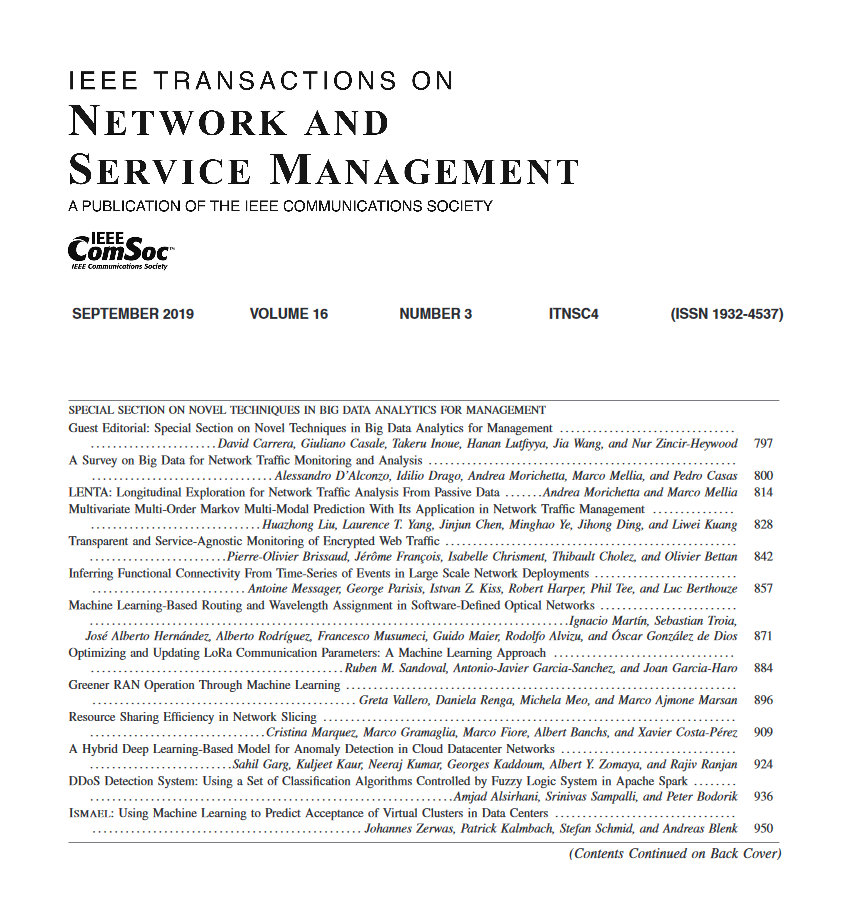ICE-CREAM: Multi-Agent Fully Cooperative Decentralized Framework for Energy Efficiency in RAN Slicing
IF 5.4
2区 计算机科学
Q1 COMPUTER SCIENCE, INFORMATION SYSTEMS
IEEE Transactions on Network and Service Management
Pub Date : 2025-01-03
DOI:10.1109/TNSM.2024.3524503
引用次数: 0
Abstract
Network slicing is one of the major catalysts proposed to turn future telecommunication networks into versatile service platforms. Along with its benefits, network slicing is introducing new challenges in the development of sustainable network operations, as it entails a higher energy consumption compared to non-sliced networks. Using a sliced architecture, which includes guaranteeing the communication and computation requirements for each slice, is essential for operators to provide a satisfying user quality of service (QoS) in a multi-service network. At the same time, building sustainable mobile networks, with the least amount of resources used, is crucial today, for both economic and environmental reasons. As a result, mobile operators need to find a middle ground between these two objectives – a tough nut considering they are both antithetical and important. In this light, we investigate a joint slice activation/deactivation and user association problem, with the aim of minimizing energy consumption and maximizing the QoS. The proposed multI-agent fully CooperativE deCentRalizEd frAMework (ICE-CREAM) addresses the formulated joint problem, with agents acting at two different granularity levels. Not only all the agents can access the shared information with their direct neighbors, but also they are trained with one global reward, which is an ideal approach in multi-agent cooperative settings. We evaluate ICE-CREAM using a real-world dataset that captures the spatio-temporal consumption of three different mobile services in France. Experimental results demonstrate that the proposed solution provides more than 30% energy efficiency improvement compared to a configuration where all the slice instances are always active while maintaining the same level of QoS. From a broader perspective, our work explicitly shows the impact of prioritizing the energy over QoS, and vice versa.ICE-CREAM:用于提高 RAN 切片能效的多代理完全合作分散式框架
网络切片是将未来电信网络转变为多功能业务平台的主要催化剂之一。除了它的好处,网络切片也给可持续网络运营的发展带来了新的挑战,因为与非切片网络相比,它需要更高的能耗。在多业务网络中,运营商要提供满意的用户服务质量(QoS),必须采用切片架构,保证每个切片的通信和计算需求。与此同时,从经济和环境两方面考虑,以最少的资源使用量建设可持续的移动网络在今天至关重要。因此,移动运营商需要在这两个目标之间找到一个中间地带——这是一个棘手的问题,因为它们既对立又重要。在这种情况下,我们研究了一个联合切片激活/去激活和用户关联问题,目的是最小化能量消耗和最大化QoS。提出的多智能体完全合作去中心化框架(冰淇淋)解决了制定的联合问题,智能体在两个不同的粒度级别上行动。不仅所有的智能体都可以访问与其直接邻居共享的信息,而且它们都是用一个全局奖励进行训练的,这是多智能体合作环境下的理想方法。我们使用真实世界的数据集来评估冰淇淋,该数据集捕获了法国三种不同移动服务的时空消费。实验结果表明,与所有切片实例始终处于活动状态同时保持相同的QoS水平的配置相比,所提出的解决方案提供了30%以上的能源效率提高。从更广泛的角度来看,我们的工作明确显示了将能量优先于QoS的影响,反之亦然。
本文章由计算机程序翻译,如有差异,请以英文原文为准。
求助全文
约1分钟内获得全文
求助全文
来源期刊

IEEE Transactions on Network and Service Management
Computer Science-Computer Networks and Communications
CiteScore
9.30
自引率
15.10%
发文量
325
期刊介绍:
IEEE Transactions on Network and Service Management will publish (online only) peerreviewed archival quality papers that advance the state-of-the-art and practical applications of network and service management. Theoretical research contributions (presenting new concepts and techniques) and applied contributions (reporting on experiences and experiments with actual systems) will be encouraged. These transactions will focus on the key technical issues related to: Management Models, Architectures and Frameworks; Service Provisioning, Reliability and Quality Assurance; Management Functions; Enabling Technologies; Information and Communication Models; Policies; Applications and Case Studies; Emerging Technologies and Standards.
 求助内容:
求助内容: 应助结果提醒方式:
应助结果提醒方式:


